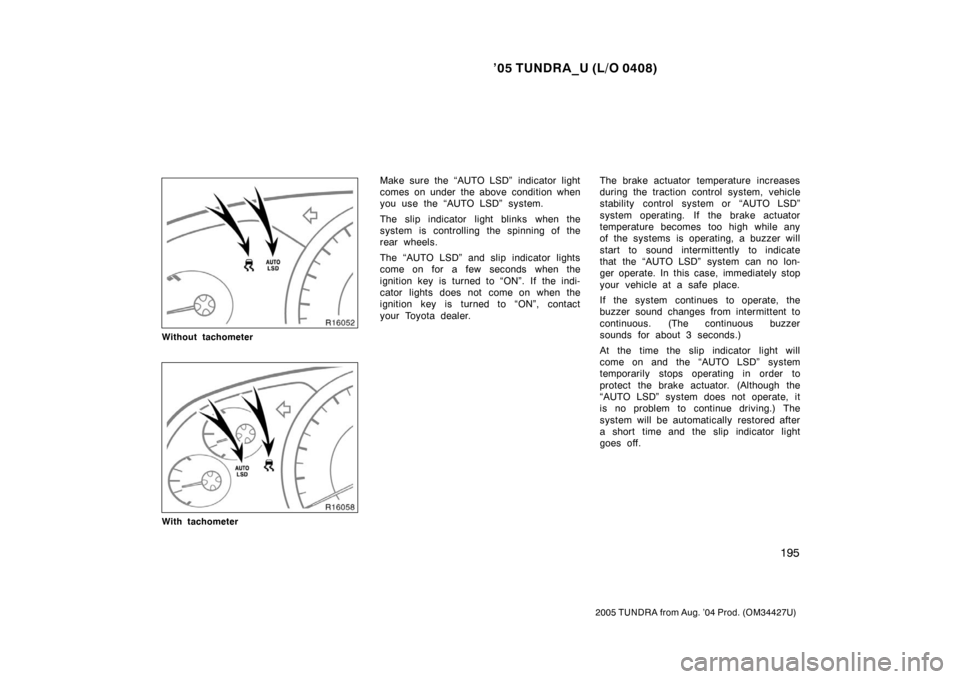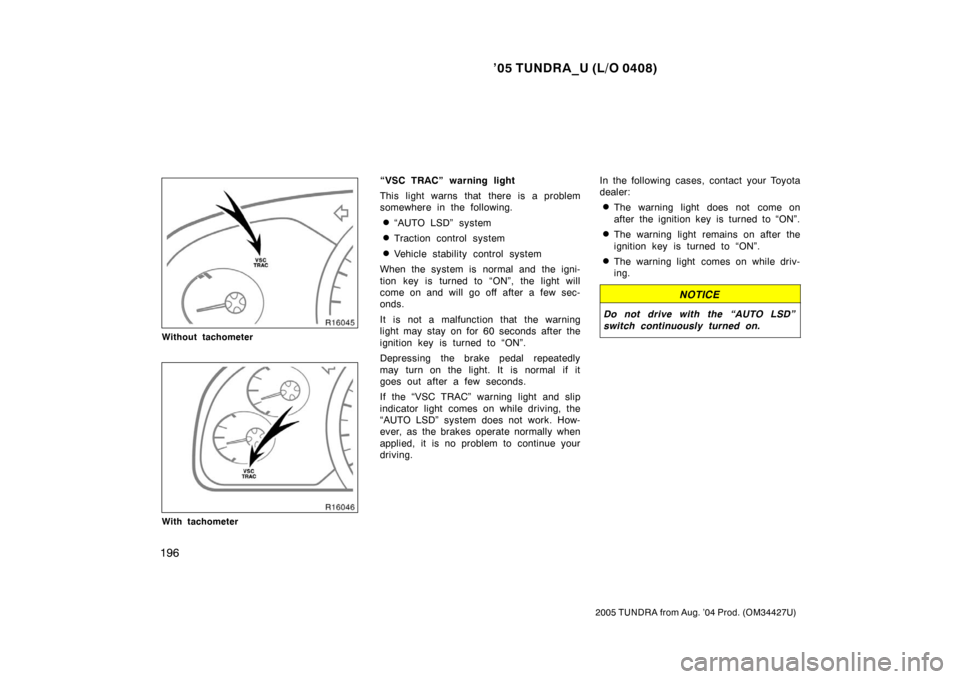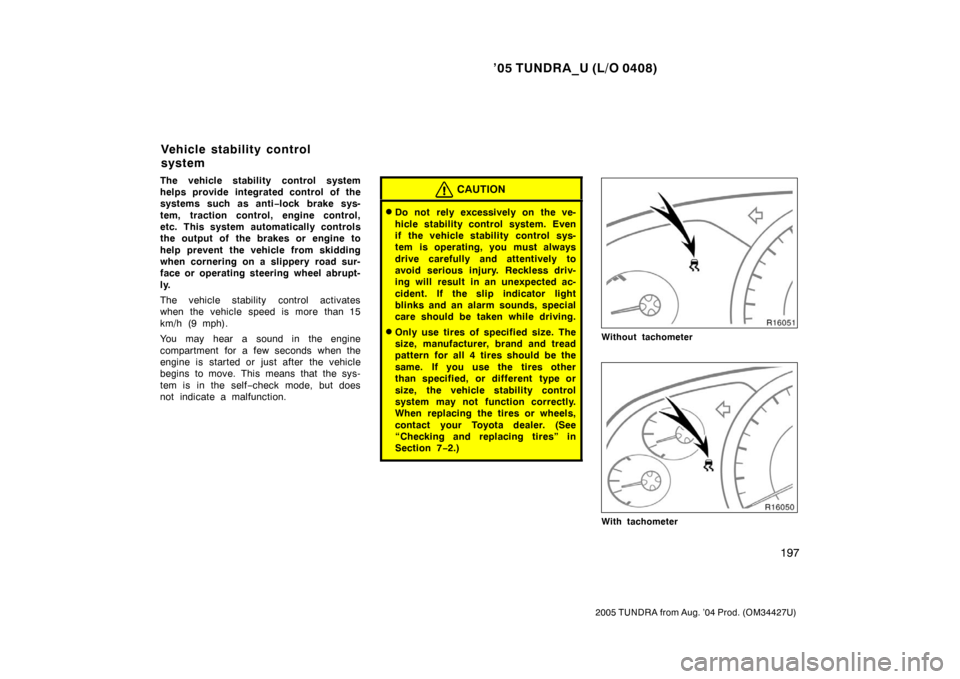Page 205 of 506
’05 TUNDRA_U (L/O 0408)
194
2005 TUNDRA from Aug. ’04 Prod. (OM34427U)
NOTICE
Do not use the “AUTO LSD” system
in conditions other than the above. A
much greater steering effort and more
careful cornering control will be re-
quired.
To activate the system, push the “AUTO
LSD” switch with the vehicle stopped.
The “AUTO LSD” is activated under the
following condition. At this time, the
“AUTO LSD” indicator light will come
on.
�The driving mode is set in the two −
wheel drive mode (in the four −wheel
drive mode, the system does not
work.)
�Driving at a speed under 100 km/h (62
mph)
To cancel the system, push the “AUTO
LSD” switch once again. If the engine is turned off while the
“AUTO LSD” indicator light is on and then
restarted, the indicator light will turn off
automatically.
Page 206 of 506

’05 TUNDRA_U (L/O 0408)
195
2005 TUNDRA from Aug. ’04 Prod. (OM34427U)
Without tachometer
With tachometer
Make sure the “AUTO LSD” indicator light
comes on under the above condition when
you use the “AUTO LSD” system.
The slip indicator light blinks when the
system is controlling the spinning of the
rear wheels.
The “AUTO LSD” and slip indicator lights
come on for a few seconds when the
ignition key is turned to “ON”. If the indi-
cator lights does not come on when the
ignition key is turned to “ON”, contact
your Toyota dealer. The brake actuator temperature increases
during the traction control system, vehicle
stability control system or “AUTO LSD”
system operating. If the brake actuator
temperature becomes too high while any
of the systems is operating, a buzzer will
start to sound intermittently to indicate
that the “AUTO LSD” system can no lon-
ger operate. In this case, immediately stop
your vehicle at a safe place.
If the system continues to operate, the
buzzer sound changes from intermittent to
continuous. (The continuous buzzer
sounds for about 3 seconds.)
At the time the slip indicator light will
come on and the “AUTO LSD” system
temporarily stops operating in order to
protect the brake actuator. (Although the
“AUTO LSD” system does not operate, it
is no problem to continue driving.) The
system will be automatically restored after
a short time and the slip indicator light
goes off.
Page 207 of 506

’05 TUNDRA_U (L/O 0408)
196
2005 TUNDRA from Aug. ’04 Prod. (OM34427U)
Without tachometer
With tachometer
“VSC TRAC” warning light
This light warns that there is a problem
somewhere in the following.
�“AUTO LSD” system
�Traction control system
�Vehicle stability control system
When the system is normal and the igni-
tion key is turned to “ON”, the light will
come on and will go off after a few sec-
onds.
It is not a malfunction that the warning
light may stay on for 60 seconds after the
ignition key is turned to “ON”.
Depressing the brake pedal repeatedly
may turn on the light. It is normal if it
goes out after a few seconds.
If the “VSC TRAC” warning light and slip
indicator light comes on while driving, the
“AUTO LSD” system does not work. How-
ever, as the brakes operate normally when
applied, it is no problem to continue your
driving. In the following cases, contact your Toyota
dealer:
�The warning light does not come on
after the ignition key is turned to “ON”.
�The warning light remains on after the
ignition key is turned to “ON”.
�The warning light comes on while driv-
ing.
NOTICE
Do not drive with the “AUTO LSD”
switch continuously turned on.
Page 208 of 506

’05 TUNDRA_U (L/O 0408)
197
2005 TUNDRA from Aug. ’04 Prod. (OM34427U)
The vehicle stability control system
helps provide integrated control of the
systems such as anti −lock brake sys-
tem, traction control, engine control,
etc. This system automatically controls
the output of the brakes or engine to
help prevent the vehicle from skidding
when cornering on a slippery road sur-
face or operating steering wheel abrupt-
ly.
The vehicle stability control activates
when the vehicle speed is more than 15
km/h (9 mph).
You may hear a sound in the engine
compartment for a few seconds when the
engine is started or just after the vehicle
begins to move. This means that the sys-
tem is in the self −check mode, but does
not indicate a malfunction.CAUTION
�Do not rely excessively on the ve-
hicle stability control system. Even
if the vehicle stability control sys-
tem is operating, you must always
drive carefully and attentively to
avoid serious injury. Reckless driv-
ing will result in an unexpected ac-
cident. If the slip indicator light
blinks and an alarm sounds, special
care should be taken while driving.
�Only use tires of specified size. The
size, manufacturer, brand and tread
pattern for all 4 tires should be the
same. If you use the tires other
than specified, or different type or
size, the vehicle stability control
system may not function correctly.
When replacing the tires or wheels,
contact your Toyota dealer. (See
“Checking and replacing tires” in
Section 7 −2.)Without tachometer
With tachometer
Vehicle stability control
system
Page 209 of 506

’05 TUNDRA_U (L/O 0408)
198
2005 TUNDRA from Aug. ’04 Prod. (OM34427U)
If the vehicle is going to skid during driv-
ing, the slip indicator light blinks and an
alarm sounds intermittently. Special care
should be taken while driving.
If the brake pedal is depressed while the
vehicle stability control system is active,
the brake pedal will become hard at an
earlier position than usual. However, the
brakes will respond to the pedal force if
depressed further.
The slip indicator light comes on for a few
seconds when the ignition key is turned
to “ON”. If the indicator light does not
come on when the ignition is turned on,
contact your Toyota dealer.Four−wheel drive models only—
Shifting the driving mode into the four −
wheel drive mode automatically turns
the vehicle stability control system off.
At this time, the “VSC OFF” indicator
comes on.
“VSC OFF” indicator light comes on for a
few seconds when the ignition key is
turned to “ON”. It will come on again
when you shift the driving mode into the
four −wheel drive mode.
In the following cases, contact your Toyota
dealer:
�The indicator light does not come on
when the ignition key is turned to
“ON”.
�The indicator light remains on after the
ignition key is turned to “ON”.
�The indicator light comes on when the
system is on while driving.
Page 210 of 506

’05 TUNDRA_U (L/O 0408)
199
2005 TUNDRA from Aug. ’04 Prod. (OM34427U)
Without tachometer
With tachometer
“VSC TRAC” warning light
This light warns that when there is a
problem somewhere in the following.
�Vehicle stability control system
�Traction control system
�“AUTO LSD” system
The light will come on when the ignition
key is turned to “ON”, and will go off after
about a few seconds.
The light may come on for 60 seconds
after the ignition key is turned to “ON”. It
is normal if they go out after a while.
Depressing the brake pedal repeatedly
may turn on the light. It is normal if they
go out after a few seconds.
If the light comes on while driving, the
vehicle stability control system does not
work. However, as the brakes operate nor-
mally when applied, it is no problem to
continue your driving. In the following cases, contact your Toyota
dealer:
�The warning light does not come on
after the ignition key is turned to “ON”.
�The warning light remains on after the
ignition key is turned to “ON”.
�The warning light comes on while driv-
ing.
The “VSC OFF” indicator light will come
on when the “VSC TRAC” warning light
comes on even if the “2WD/4HI” or “4LO”
switch is not pushed.
Page 211 of 506

’05 TUNDRA_U (L/O 0408)
200
2005 TUNDRA from Aug. ’04 Prod. (OM34427U)
The tire pressure warning system is de-
signed to provide warning when tire
inflation pressure of one or more of
your tires (including the spare tire) is
low. The low tire pressure warning light
comes on to inform you that low tire
inflation pressure may hamper driving.
Without tachometer
With tachometer
LOW TIRE PRESSURE WARNING LIGHT
This light comes on when the ignition key
is turned to the “ON” position. It goes off
after a few seconds. This indicates that
the tire pressure warning system is func-
tioning properly.
If the low tire pressure warning light
comes on or blinks, do the following.
If the warning light comes on:
Stop your vehicle in a safe place as
soon as possible and check that the
inflation pressure of all tires (including
the spare tire) is as specified on the
tire and loading information label. (See
“Checking tire inflation pressure” in
Section 7 −2.) If the warning light comes
on even after tire inflation pressure ad-
justment, you may have a flat tire. If
you have a flat tire, replace it with the
spare tire. For details, see “If you have
a flat tire” in Section 4.
The warning light goes off a few minutes
after air is put into the deflated tire.
This warning light may turn on due to
natural causes such as natural air leaks
or tire pressure changes caused by tem-
perature. In this case, adjusting the tire
pressure will turn off the warning light.
Tire pressure warning
system—
Page 212 of 506

’05 TUNDRA_U (L/O 0408)
201
2005 TUNDRA from Aug. ’04 Prod. (OM34427U)
CAUTION
When the tire pressure warning light
comes on, observe the following in-
structions:
�Depending on the conditions, re-
duce to an appropriate speed as
soon as possible.
�Adjust the tire pressure to the spe-
cified level as soon as possible.
�Avoid abrupt steering wheel maneu-
vering and braking. Tire deteriora-
tion may reduce steering wheel con-
trol and brake effectiveness. This
may lead to serious injury or death.
�The tire pressure warning system
may not activate immediately if sud-
den bursts of air leakage occur.
NOTICE
�Do not use liquid sealants for a flat
tire as air pressure sensors will be
damaged.
� When the tires must be repaired or
replaced, have them repaired or re-
placed by the nearest Toyota dealer
or authorized tire dealer. The tire
pressure sensors will be affected by
the installation or removal of tires.
� The tire pressure warning system is
not to be used as a substitute for
regular inspections. Be sure to
check the air pressure in the tires
on a regular basis.
� When the tires must be replaced,
replace the grommets for air pres-
sure sensors as well.
If the warning light blinks:
The tire pressure warning system may
be malfunctioning. Contact your Toyota
dealer.
SYSTEM MALFUNCTION
The tire pressure warning system does
not function properly under certain cir-
cumstances. In the following cases, the
low tire pressure warning light may not
come on even if the tire inflation pres-
sure is low, or it may come on when
the tire inflation pressure is actually
normal.
�Electric devices or facilities using simi-
lar radio wave frequencies are nearby.
�A radio set to similar frequencies is in
use.
�A lot of snow or ice covers the ve-
hicle, in particular, around the wheels
or wheel housings.
�The tires are not equipped with an air
pressure sensor.
�Snow tires or tire chains are used.
�Non −genuine Toyota wheels are used.
�The sensor battery is expired.
�Radio waves from the air pressure sen-
sor installed on the spare tire cannot
be received.